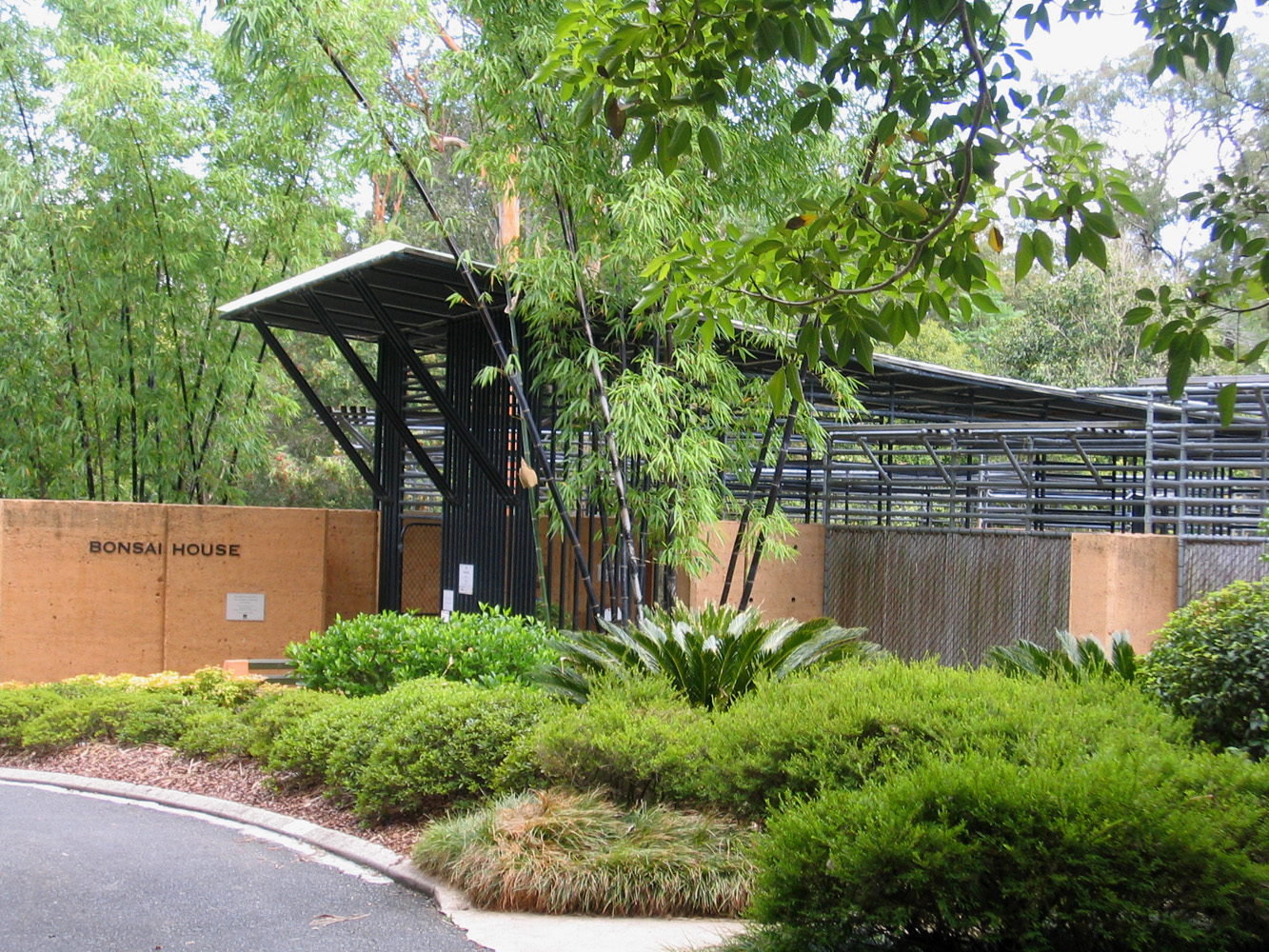|
Brisbane Botanic Gardens, Mount Coot-tha
The Brisbane Botanic Gardens (formerly the Mount Coot-tha Botanic Gardens and informally the Toowong Botanic Gardens) are located from the Brisbane CBD at the foot of Brisbane's tallest mountain, Mount Coot-tha in the suburb of Mount Coot-tha, Queensland, Australia. History The gardens, which were originally called the Mount Coot-tha Botanic Gardens and which cover , were established by the Brisbane City Council in 1970, and officially opened in 1976. The gardens are the second botanical gardens established in Brisbane. The original gardens, now known as the City Botanic Gardens are located in the Brisbane CBD at Gardens Point. The new gardens were developed by the City Council because the original city site could not be expanded and was flood prone. The Mount Coot-tha Library at the gardens opened in 1975. Features Features of the Brisbane Botanic Gardens include: * Tropical Display Dome — opened in December 1977, 28 m in diameter and 9 m high * Japanese Garden * Bon ... [...More Info...] [...Related Items...] OR: [Wikipedia] [Google] [Baidu] |
Mount Coot-tha, Queensland
Mount Coot-tha is a mountain and a Suburbs and localities (Australia), suburb of the City of Brisbane, Queensland, Australia. In the , there were no residents in the suburb. Visible from much of the city, Mount Coot-tha is a popular bushland tourist destination including the Mount Coot-tha Lookout, Brisbane Botanic Gardens, Mount Coot-tha, Brisbane Botanic Gardens and Sir Thomas Brisbane Planetarium, as well as a mountain drive, bike trails, parks including a waterfall, and television and radio towers. Geography The mountain Mount Coot-tha forms the eastern extent of the Taylor Range and is a prominent landmark approximately to the west of the Brisbane central business district. Mount Coot-tha is the source of Ithaca Creek. The mountain has a number of named peaks in the suburb: * Constitution Hill () * Mount Coot-tha () * The Pinnacle (), * The Summit () Sir Samuel Griffith Scenic Drive is a loop road around the mountain, passing by (clockwise) Mount Coot-tha, Con ... [...More Info...] [...Related Items...] OR: [Wikipedia] [Google] [Baidu] |
Botany
Botany, also called , plant biology or phytology, is the science of plant life and a branch of biology. A botanist, plant scientist or phytologist is a scientist who specialises in this field. The term "botany" comes from the Ancient Greek word (''botanē'') meaning " pasture", " herbs" "grass", or " fodder"; is in turn derived from (), "to feed" or "to graze". Traditionally, botany has also included the study of fungi and algae by mycologists and phycologists respectively, with the study of these three groups of organisms remaining within the sphere of interest of the International Botanical Congress. Nowadays, botanists (in the strict sense) study approximately 410,000 species of land plants of which some 391,000 species are vascular plants (including approximately 369,000 species of flowering plants), and approximately 20,000 are bryophytes. Botany originated in prehistory as herbalism with the efforts of early humans to identify – and later cultivate – ed ... [...More Info...] [...Related Items...] OR: [Wikipedia] [Google] [Baidu] |
Ikebana
is the Japanese art of flower arrangement. It is also known as . The tradition dates back to Heian period, when floral offerings were made at altars. Later, flower arrangements were instead used to adorn the (alcove) of a traditional Japanese home. reached its first zenith in the 16thcentury under the influence of Buddhist tea masters and has grown over the centuries, with numerous distinct schools extant today. is counted as one of the three classical Japanese arts of refinement, along with for incense appreciation and for tea and the tea ceremony. Etymology is from the Japanese and . Possible translations include "giving life to flowers" and "arranging flowers". History The pastime of viewing plants and appreciating flowers throughout the four seasons was established in Japan early on through the aristocracy. poetry anthologies such as the and from the Heian period (794–1185) included many poems on the topic of flowers. With the introduction of Budd ... [...More Info...] [...Related Items...] OR: [Wikipedia] [Google] [Baidu] |
Japanese Calligraphy
also called is a form of calligraphy, or artistic writing, of the Japanese language. Written Japanese was originally based on Chinese characters only, but the advent of the hiragana and katakana Japanese syllabaries resulted in intrinsically Japanese calligraphy styles. Styles The term shodō (書道, "way of writing") is of Chinese origin, and is widely used to describe the art of Chinese calligraphy during the medieval Tang dynasty. Early Japanese calligraphy was originated from Chinese calligraphy. Many of its principles and techniques are very similar, and it recognizes the same basic writing styles: * seal script (篆書 ''tensho'') (pinyin: ''zhuànshū''). The seal script (tensho) was commonly used throughout the Zhou dynasty (1046–256 BC) and the following Qin dynasty (221–206 BC) of China. After this time period, tensho style fell out of popularity in favor of reisho. However, tensho was still used for titles of published works or inscriptions. The c ... [...More Info...] [...Related Items...] OR: [Wikipedia] [Google] [Baidu] |
Japanese Tea Ceremony
The Japanese tea ceremony (known as or ) is a Japanese cultural activity involving the ceremonial preparation and presentation of , powdered green tea, the procedure of which is called . While in the West it is known as "tea ceremony", it is seldom ceremonial in practice. Most often tea is served to family, friends, and associates; religious and ceremonial connotations are overstated in western spaces. While in the West it is known as a form of tea ceremony, in Japan the art and philosophy of tea can be more accurately described as "Teaism" as opposed to focusing on the ceremonial aspect. Zen Buddhism was a primary influence in the development of the culture of Japanese tea. Much less commonly, Japanese tea practice uses leaf tea, primarily , a practice known as . Tea gatherings are classified as either an informal tea gathering () or a formal tea gathering (). A is a relatively simple course of hospitality that includes confections, thin tea, and perhaps a light meal. A is a ... [...More Info...] [...Related Items...] OR: [Wikipedia] [Google] [Baidu] |
Tea Ceremony
An East Asian tea ceremony, or ''Chádào'' (), or ''Dado'' ( ko, 다도 (茶道)), is a ceremonially ritualized form of making tea (茶 ''cha'') practiced in East Asia by the Chinese, Japanese, and Koreans. The tea ceremony (), literally translated as either "''way of tea''", "''etiquette for tea or tea rite''", or "''art of tea''" in any of the three East Asian languages, is a cultural activity involving the ceremonial preparation and presentation of tea. The Japanese tea ceremony and Korean tea ceremony were influenced by the Chinese tea culture during ancient and medieval times, starting in the 9th century when tea was first introduced to Japan and Korea from China. One can also refer to the whole set of rituals, tools, gestures, etc. used in such ceremonies as tea culture. All of these tea ceremonies and rituals contain "an adoration of the beautiful among the sordid facts of everyday life", as well as refinement, an inner spiritual content, humility, restraint and simplicity ... [...More Info...] [...Related Items...] OR: [Wikipedia] [Google] [Baidu] |
Noboru Takeshita
was a Japanese politician who served as Prime Minister of Japan from 1987 to 1989 during the bubble economy. Takeshita led the largest faction at the time in the Liberal Democratic Party, which he inherited from Kakuei Tanaka, from the 1980s until his death in 2000. He was dubbed the "last shadow shogun" for his behind-the-scenes influence in Japanese politics. He was the last prime minister to serve during the long rule of Emperor Hirohito.Sanger, David E. "Takeshita Now Admits World War II Aggression,"''New York Times.'' 7 March 1989. He is the grandfather of musician and actor Daigo. Early life and education Noboru Takeshita was born on 26 February 1924, in present-day Unnan, Shimane Prefecture, the son of a sake brewer. His family had been sake brewers for generations, and Takeshita was the 20th head of the Takeshita brewing family. Both his father Yūzō and his grandfather Gizō had been men of high repute in the region, and Takeshita followed in their footsteps and decid ... [...More Info...] [...Related Items...] OR: [Wikipedia] [Google] [Baidu] |
Prime Minister Of Japan
The prime minister of Japan (Japanese: 内閣総理大臣, Hepburn: ''Naikaku Sōri-Daijin'') is the head of government of Japan. The prime minister chairs the Cabinet of Japan and has the ability to select and dismiss its Ministers of State. The prime minister also serves as the civilian commander-in-chief of the Japan Self Defence Forces and as a sitting member of the House of Representatives. The individual is appointed by the emperor of Japan after being nominated by the National Diet and must retain the nomination of the lower house and answer to parliament to remain in office. The position and nature of this title allow the holder to reside in and work at the Prime Minister's Official Residence in Nagatacho, Chiyoda, Tokyo, close to the National Diet Building. Fumio Kishida is the current prime minister of Japan, replacing Yoshihide Suga on 4 October 2021. As of , there have been 102 prime ministers. Designation Abbreviations In Japanese, due to the special ... [...More Info...] [...Related Items...] OR: [Wikipedia] [Google] [Baidu] |
Sallyanne Atkinson
Sallyanne Atkinson AO (born 23 July 1942) was Lord Mayor of Brisbane from 1985 to 1991 in Queensland, Australia. She is the only woman to have held the position. As of 2017, she was Chairman of the Museum of Brisbane, President of the Council of The Women's College at the University of Queensland and chair of the advisory board of the Queensland Brain Institute at the University of Queensland. Early life Atkinson was born in Sydney.Sallyanne Atkinson Our House, ninemsn.com.au She attended Bishop's College and the Royal Naval School in , Sri Lanka and completed ... [...More Info...] [...Related Items...] OR: [Wikipedia] [Google] [Baidu] |
Expo '88
World Expo 88, also known as Expo 88, was a specialised Expo held in Brisbane, the state capital of Queensland, Australia, during a six-month period between Saturday, 30 April 1988 and Sunday, 30 October 1988, inclusive. The theme of the Expo was "Leisure in the Age of Technology", and the mascot for the Expo was an Australian platypus named Expo Oz. The A$625 million fair was the largest event of the 1988 Bicentennial celebrations of the arrival of the First Fleet in Sydney Harbour. Expo 88 attracted more than 15,760,000 visitors who bought tickets worth A$175 million. The event achieved both its economic aims and very good attendances, was successfully used to promote Queensland as a tourist destination and it spurred a major re-development at the South Brisbane site. The core feature of the site were the international pavilions. Many of the exposition's sculptures and buildings were retained by various entities around the state and are still in use or on display today. Histo ... [...More Info...] [...Related Items...] OR: [Wikipedia] [Google] [Baidu] |
Japanese Garden
are traditional gardens whose designs are accompanied by Japanese aesthetics and philosophical ideas, avoid artificial ornamentation, and highlight the natural landscape. Plants and worn, aged materials are generally used by Japanese garden designers to suggest a natural landscape, and to express the fragility of existence as well as time's unstoppable advance. Ancient Japanese art inspired past garden designers. Water is an important feature of many gardens, as are rocks and often gravel. Despite there being many attractive Japanese flowering plants, herbaceous flowers generally play much less of a role in Japanese gardens than in the West, though seasonally flowering shrubs and trees are important, all the more dramatic because of the contrast with the usual predominant green. Evergreen plants are "the bones of the garden" in Japan. Though a natural-seeming appearance is the aim, Japanese gardeners often shape their plants, including trees, with great rigour. Japanese literatu ... [...More Info...] [...Related Items...] OR: [Wikipedia] [Google] [Baidu] |








